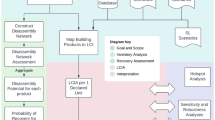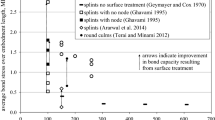Abstract
This research aims to assess the sustainability of the most common earth-retaining walls (Gravity Walls and Cantilever Walls) in terms of environmental impacts, economic issues, and their combination. Gravity walls observed in this study consist of Gabion Wall, Crib Wall, and Rubble Masonry Wall, while Cantilever Walls include Reinforced Concrete Wall. Six different criteria were taken into account, including global warming potential, fossil depletion potential, eutrophication potential, acidification potential, human toxicity potential, and cost. To achieve the aim of this study, life cycle assessments, life cycle costs, and multi-criteria decision-making methods were implemented. The results showed that the most environmental-friendly option among all alternatives was the Gabion Wall, followed by the Rubble Masonry Wall. However, in terms of economic aspects, the Cantilever Concrete Wall was the best option, costing about 17% less than the Gabion Wall. On the other hand, the results of multi-criteria decision-making showed that the Gabion Wall was the most sustainable choice. This study addressed the research gap by carrying out a sustainability assessment of different retaining walls while considering cost and environmental impacts at the same time.





Similar content being viewed by others
Data availability
The datasets used and analyzed during the current study are available from the corresponding author on reasonable request
References
Akasah ZA, Rum NAM (2012) Implementing life cycle costing in Malaysia construction industry: a review. In: Proceeding of International Building and Infrastructure Conference, 7–8 June 2011
Balasbaneh AT, Bin Marsono AK (2017) Proposing of new building scheme and composite towards global warming mitigation for Malaysia. Int J Sustain Eng 10(3). https://doi.org/10.1080/19397038.2017.1293184
Balasbaneh A T, Bin Marsono A K (2020) Applying multi-criteria decision-making on alternatives for earth-retaining walls : LCA , LCC , and S-LCA. Int. J. Life Cycle Assess. 2140–2153. https://doi.org/10.1007/s11367-020-01825-6
Balasbaneh A T, Ramli M Z (2020) A comparative life cycle assessment (LCA) of concrete and steel-prefabricated prefinished volumetric construction structures in Malaysia. Environ. Sci. Pollut. Res. 43186–43201. https://doi.org/10.1007/s11356-020-10141-3
Balasbaneh AT, Bin Marsono AK, Kermanshahi KE (2018) Balancing of life cycle carbon and cost appraisal on alternative wall and roof design verification for residential building. Constr Innov 18(3):274–300. https://doi.org/10.1108/CI-03-2017-0024
Boesch ME, Hellweg S (2010) Identifying improvement potentials in cement production with life cycle assessment. Environ Sci Technol 44(23):9143–9149. https://doi.org/10.1021/es100771k
Brandl H (1980) Tragverhalten und Dimensionierung von Raumgitterstu¨tzmauern (Krainerwa¨nden)-Bundesministerium fu¨r Bauten und Technik, Straßenforschung Heft 141, Vienna, pp 115–220
Broadbent C (2016) Steel’s recyclability: demonstrating the benefits of recycling steel to achieve a circular economy. Int J Life Cycle Assess 21(11):1658–1665. https://doi.org/10.1007/s11367-016-1081-1
CML - Department of Industrial Ecology (2016) CML-IA characterisation factors [Online]. Netherlands University Leiden. Available: https://www.universiteitleiden.nl/en/research/research-output/science/cml-ia-characterisation-factors. Accessed 20 May 2020
Code B (2015) Ibc 2015. In Ibc 2015
Colas A, Garnier D, Habert G, Tardivel Y (2014) Advances on structural, environmental and economical analysis of dry-stone retaining walls. SAHC2014 - 9th International Conference on Structural Analysis of Historical Constructions, October, 14–17
Damians IP, Bathurst RJ, Adroguer EG, Josa A, Lloret A (2016) Sustainability assessment of earth-retaining wall structures. Environ Geotechn 5(4):187–203. https://doi.org/10.1680/jenge.16.00004
Department of Statistic M (2012–2015) Quarterly construction statistics. Retrieved from Department of Statistics Malaysia. https://newss.statistics.gov.my/newss-portalx/ep/epProductFreeDownloadSearch.seam
Ekvall T, Weidema BP (2004) System boundaries and input data in consequential life cycle inventory analysis. Int J Life Cycle Assess 9(3):161–171. https://doi.org/10.1007/BF02994190
El Hanandeh A (2015) Energy recovery alternatives for the sustainable management of olive oil industry waste in Australia: Life cycle assessment. J Clean Prod 91:78–88
Frischknecht R, Büsser-Knöpfel S, Itten R, Stucki M, Wallbaum H (2013) Comparative life cycle assessment of geosynthetics versus concrete retaining wall. 18th. Int Conf Soil Mech Geotech Eng Challenges Innov Geotech ICSMGE 2013(3):1979–1982
Giri RK, Reddy KR (2015) Sustainability assessment of two alternate earth-retaining structures. Geotech Spec Publ GSP 256:2836–2845. https://doi.org/10.1061/9780784479087.265
Goedkoop M, Heijungs R, Huijbregts M, De Schryver A, Struijs J, van Zelm R, (2013) ReCiPe 2008 - Report I: Characterisation (Netherlands).
Gustavsson L, Pingoud K, Sathre R (2006) Carbon dioxide balance of wood substitution: comparing concrete- and wood-framed buildings. Mitig Adapt Strateg Glob Chang 11(3):667–691. https://doi.org/10.1007/s11027-006-7207-1
Henkel H-JK (2005) Editorial The Revision of ISO Standards 14040 − 3. Int J Life Cycle Assess 10(3):1
Hermann BG, Kroeze C, Jawjit W (2007) Assessing environmental performance by combining life cycle assessment, multi-criteria analysis and environmental performance indicators. J Clean Prod 15:1787–1796
Highways Agency (1999) Design manual for roads and bridges. Standardsforhighways.Co.Uk 2(August 1999):187
Hopper LJ (2012) Landscape architectural graphic standards, 576 Pages. Publisher : John Wiley & Sons Published Date : 2012-02-24
International Code Council (ICC) (2012) IBC® code and commentary. 2 vols. ICC., Country Club Hills
Ioannidou D, Zerbi S, Habert G (2014) When more is better – comparative LCA of wall systems with stone. Build Environ 82:628–639. https://doi.org/10.1016/j.buildenv.2014.10.004
Kamali M, Hewage K, Sadiq R (2019) Conventional versus modular construction methods: a comparative cradle-to-gate LCA for residential buildings. Energy Build. 204. https://doi.org/10.1016/j.enbuild.2019.109479
Khan RA, Liew MS, Ghazali ZB (2014) Malaysian construction sector and Malaysia Vision 2020: developed nation status. Procedia - Social Behav Sci 109 (Supplement C):507–513
Martínez Rocamora A, Solís-Guzmán J, Marrero M (2017) Ecological footprint of the use and maintenance phase of buildings: maintenance tasks and final results. Energy Build 155:339–351
Modular Gabion Systems (2004) Gabion Walls design. Modular Gabion Systems. https://www.google.com/searchei=TsgYIP1EMnFrQHW75co&q=odular+Gabion+Systems.+%282004%29+Gabion+Walls+Design.+Modular+Gabion+Systems%2C+1%E2%80%9312.&oq=odular+Gabion+Systems.+%282004%29+Gabion+Walls+Design.+Modular+Gabion+Systems%2C+1%E2%ved=0ahUKEwiD1LHf35LvAhXJYisKHdb3BQUQ4dUDCA0&uact=5. Accessed 21 May 2019
Molina-Moreno F, García-Segura T, Martí JV, Yepes V (2017) Optimization of buttressed earth-retaining walls using hybrid harmony search algorithms. Eng Struct 134:205–216. https://doi.org/10.1016/j.engstruct.2016.12.042
MY-LCID. Malaysia Life Cycle Inventory Database. Available online: http://mylcid.sirim.my/sirimlca/ (accessed on 21 May 2019).
Pons O, Wadel G (2011) Environmental impacts of prefabricated school buildings in Catalonia. Habitat Int 35(4):553–563. https://doi.org/10.1016/j.habitatint.2011.03.005
Pons JJ, Penadés-Plà V, Yepes V, Martí JV (2018) Life cycle assessment of earth-retaining walls: an environmental comparison. J Clean Prod 192:411–420. https://doi.org/10.1016/j.jclepro.2018.04.268
Ramesh T, Prakash R, Shukla KK (2010) Life cycle energy analysis of buildings: an overview. Energy Build 42:1592–1600
Saaty TL (2008) Decision making with the analytic hierarchy process. Int J Services Sci 1(1):83–98
Saifulsyahira J, Edre MA, Ahmad Farhan AF, Muhamad Hanafiah J (2016) Governance of flood disaster management: Malaysia case study. Int J Public Heal Clin Sci 3:17–30
Söderholm P, Ekvall T (2020) Metal markets and recycling policies: impacts and challenges. Miner Econ 33(1–2):257–272. https://doi.org/10.1007/s13563-019-00184-5
Stewart MG, Wang X, Nguyen MN (2011) Climate change impact and risks of concrete infrastructure deterioration. Eng Struct 33:1326–1337
Tait MW, Cheung WM (2016) A comparative cradle-to-gate life cycle assessment of three concrete mix designs. Int J Life Cycle Assess 21:847–860
Turskis Z, Zavadskas EK, Peldschus F (2009) Multi-criteria optimization system for decision making in construction design and management. Eng Econ 1:7–17
Villalba P, Alcalá J, Yepes V, González-Vidosa F (2010) CO2 optimization of reinforced concrete cantilever retaining walls. 2nd International Conference on Engineering Optimization, September, 6–9. http://webcache.googleusercontent.com/search?q=cache:9_TyM-tSN5wJ:www1.dem.ist.utl.pt/engopt2010/Book_and_CD/Papers_CD_Final_Version/pdf/01/01171-01.pd+&cd=1&hl=en&ct=clnk&gl=my
Wüthrich D, Chanson H (2014) Hydraulics, air entrainment, and energy dissipation on a gabion stepped weir. J Hydraul 140(9):1–10. https://doi.org/10.1061/(ASCE)HY.1943-7900.0000919
Yau YH, Hasbi S (2013) A review of climate change impacts on commercial buildings and their technical services in the tropics. Renew. Sustain. Energy Rev 18:430–441. https://doi.org/10.1016/j.rser.2012.10.035
Yepes V, Gonzalez-Vidosa F, Alcala J, Villalba P (2012) CO 2-optimization design of reinforced concrete retaining walls based on a VNS-threshold acceptance strategy. J Comput Civ Eng 26(3):378–386. https://doi.org/10.1061/(ASCE)CP.1943-5487.0000140
Yepes V, Martí JV, García-Segura T (2015) Cost and CO2 emission optimization of precast-prestressed concrete U-beam road bridges by a hybrid glowworm swarm algorithm. Autom Constr 49:123–134
Zastrow P, Molina-Moreno F, García-Segura T, Martí JV, Yepes V (2017) Life cycle assessment of cost-optimized buttress earth-retaining walls: a parametric study. J Clean Prod 140:1037–1048. https://doi.org/10.1016/j.jclepro.2016.10.085
Zavadskas EK, Kaklauskas A (1996) Determination of an efficient contractor by using the new method of multi-criteria assessment, [in:] D. A. Langford, A. Retik (Eds.) International Symposium for “The Organisation and Management of Construction”. Shaping Theory and Practice, Vol. 2: Managing the Construction Project and Managing Risk, CIB W 65; London, Weinheim, New York, Tokyo, Melbourne, Madras, London: E and FN SPON, pp. 94–104
Zavadskas EK, Turskis Z, Kildiene S (2014) State of art surveys of overviews on MCDM/MADM methods. Technol Econ Dev Econ 20:165–179
Author information
Authors and Affiliations
Contributions
All authors contributed to the study conception and design. Data collection and software analysis were performed by Ali Tighnavard Balasbaneh, David Yeoh, and Mohd Irwan Juki. The first draft of the manuscript was written by Ali Tighnavard Balasbaneh, mohd haziman wan Ibrahim, and Ahmad Razin Zainal Abidi; all the authors commented on previous versions of the manuscript. All the authors read and approved the final manuscript.
Corresponding author
Ethics declarations
Ethics approval and consent to participate
Not applicable
Consent to participate
Not applicable.
Consent for publication
Not applicable.
Competing interests
The authors declare that they have no competing interests.
Additional information
Responsible editor: Philippe Loubet
Publisher’s note
Springer Nature remains neutral with regard to jurisdictional claims in published maps and institutional affiliations.
Appendix
Appendix
Criteria | S1 | S2 | S3 | S4 |
|---|---|---|---|---|
IPCC GWP 100a | 0.007 | 0.063 | 0.050 | 0.083 |
Fossil Depletion Potential | 0.002 | 0.039 | 0.031 | 0.078 |
Human-toxicity Potential | 0.016 | 0.037 | 0.034 | 0.063 |
Acidification | 0.010 | 0.025 | 0.019 | 0.040 |
Eutrophication | 0.012 | 0.028 | 0.025 | 0.077 |
cost | 0.063 | 0.079 | 0.064 | 0.053 |
Rights and permissions
About this article
Cite this article
Balasbaneh, A.T., Yeoh, D., Juki, M.I. et al. Assessing the life cycle study of alternative earth-retaining walls from an environmental and economic viewpoint. Environ Sci Pollut Res 28, 37387–37399 (2021). https://doi.org/10.1007/s11356-021-13190-4
Received:
Accepted:
Published:
Issue Date:
DOI: https://doi.org/10.1007/s11356-021-13190-4




